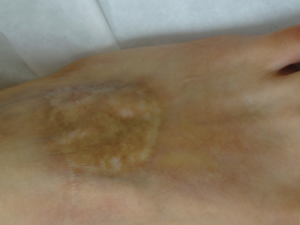Chapter 10: Inflammatory Skin Conditions
Morphea
What is it?
Morphea is an inflammatory condition that leads to hardening of the skin.

What does it look like?
Morphea presents with indurated (hardened), atrophic (indented) plaques with pigmentary change. Active lesions are often red with a purple border, but older lesions tend to by hyper- or hypo-pigmented. Lesions may be oval (plaque type) or form a straight line (linear type) and the distribution varies from a single plaque to widespread disease. A common childhood variant is en coup de sabre in which linear morphea affects the forehead and/or frontal scalp.
How is it managed?
Localized morphea might be treated with potent topical steroids, but most patients are treated with systemic agents such as prednisone or methotrexate, or with a specialized form of phototherapy, UVA1.
Does it cause problems?
Morphea can lead to complications. If it crosses joints it may cause contractures. Significant facial involvement can lead to complications in the eyes, mouth and/or brain. There may be cosmetic considerations as atrophy can create noticeable asymmetry.
What is the differential diagnosis?
Systemic sclerosis is the systemic form of scleroderma. In this condition, hardening of the skin begins with the fingers (sclerodactyly), and spreads proximally. It is accompanied by other skin findings such as Raynaud phenomenon, telangiectasia and calcinosis cutis. The lungs, heart, blood vessels and esophagus may also be affected.
Lichen sclerosus is another skin condition in which there is hardening of the skin. It most often affects the genital and perianal skin and is shiny white in colour (described as “porcelain” appearance) due to atrophy. If left untreated complications include fusion of the labia in women and phimosis in men. Treatment is with high-potency topical steroids and calcineurin inhibitors.

